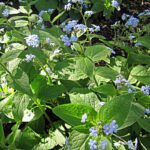Flowering Ground Covers
I can’t figure out the precise point when a fast spreading plant becomes a ground cover. Some, like ivy, periwinkle and the beautiful blue flowering plumbago in the picture, are quite obvious, others, like lily of the valley and sweet violets, take you by surprise, starting with a shy little clump in spring and filling the garden with their prolific progeny in one season.
I guess if we define as perennial ground cover any plant that fills up all the space it occupies, we can expand the list to include daylilies, beebalms, tickseed, irises, raspberry thickets and strawberry patches.
I have become quite appreciative of ground covers’ qualities, especially for shady borders or dry, sun baked areas that are difficult to keep presentable. Once these unpretentious plants acclimate to an area, they will be happy to fill it, not allowing room for weeds and covering unsightly bare patches with healthy looking foliage. Many of them bloom to bring fragrance to the garden and fill the spaces around larger perennials, where their compact foliage shade their roots, spans the gaps between their flushes of bloom and allows them to hold on to their water longer.
It is true that some ground covers need to be contained, otherwise they take over as large an area as they have access to, but in many circumstances, their eager spreading habit is a feature, not a drawback.
For dry shade in particular, where just the fact that anything will thrive is a blessing, pachysandra, ivy, vinca, and sweet woodruff make very useful plants.
I always look forward to the beginning of fall, when this blue flowered princess takes first stage in the garden. Its blossoms always make me smile, it’s impossible not to love it.




 Previous Post
Previous Post Next Post
Next Post




